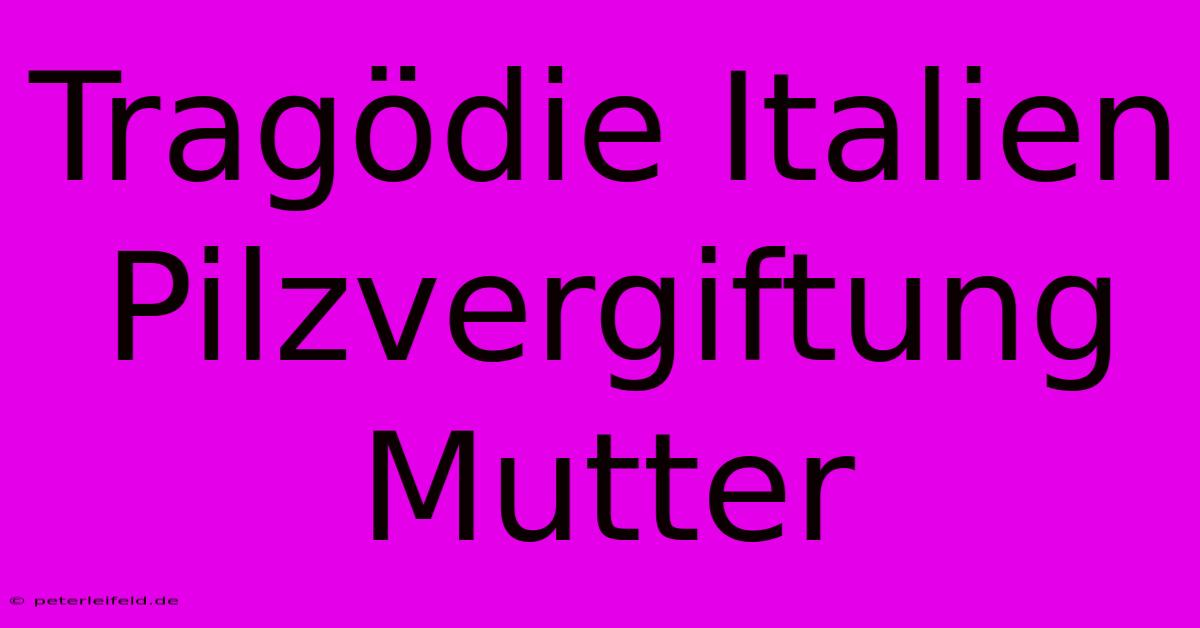Tragödie Italien Pilzvergiftung Mutter

Discover more detailed and exciting information on our website. Click the link below to start your adventure: Visit Best Website Tragödie Italien Pilzvergiftung Mutter. Don't miss out!
Table of Contents
Tragödie Italien: Pilzvergiftung – Eine Mutter verliert ihr Leben
This is a tough one to write, honestly. The loss of a loved one, especially in such a tragic way, is devastating. I can't imagine the pain the family is going through. My heart goes out to them. This article isn't about exploiting their grief; it's about learning from this terrible event and preventing similar tragedies. It's about pilzvergiftung in Italy, and the importance of pilzbestimmung.
I remember a time, years ago, when my uncle, a total pilz-pro, took me mushroom hunting in the Black Forest. He was super cautious, though, always stressing the importance of pilzarten bestimmen. He knew a mistake could be fatal. We spent hours carefully examining every mushroom, comparing it to his well-worn guidebook. Even then, he always double-checked with an expert before we even thought about cooking anything. That experience really hammered home the risks involved.
This recent tragedy in Italy highlights the very real dangers of misidentifying mushrooms. Apparently, the mother mistakenly consumed giftige pilze believing them to be edible varieties. This underscores the crucial need for extreme caution when foraging or consuming wild mushrooms. You just can't be too careful.
Die Gefahren von Pilzvergiftung
Pilzvergiftung, or mushroom poisoning, can range from mild discomfort to death. Symptoms can vary wildly depending on the type of mushroom, and even the amount consumed. Some mushrooms have immediate effects, while others have a delayed reaction, making diagnosis difficult. That delay can be truly dangerous.
It's important to understand that there are no quick, easy ways to tell a poisonous mushroom from an edible one. Things like color, smell, or even the presence of insects aren't reliable indicators. Trust me, I’ve tried some of those “old wives’ tales” myself, and they're total bunk.
This brings us to the absolutely critical point: Never eat a wild mushroom unless you are 100%, absolutely certain of its identification.
Sicherer Umgang mit Pilzen
So, what can we do to stay safe? Here's my advice, drawn from personal experience and research:
- Go with an expert: If you're new to mushroom hunting, go with someone who knows their stuff. Join a local mycological society or hire a professional guide. It's way better to learn from the best then to learn the hard way.
- Use multiple sources: Don't rely on just one identification guide. Compare your findings across several reputable sources, including field guides and online databases. Cross-referencing is key.
- When in doubt, throw it out: This is the golden rule. If you're even slightly unsure about a mushroom's identity, don't eat it. It's simply not worth the risk. Seriously, it's not.
- Cook thoroughly: Even with correctly identified edible mushrooms, thorough cooking is essential to destroy potential toxins. Don't eat raw wild mushrooms!
- Know where you're foraging: Be aware of the local environment. Certain areas may have more poisonous mushrooms than others.
- Seek medical attention immediately: If you suspect mushroom poisoning, seek medical attention immediately. Take a sample of the mushroom with you for identification purposes.
The tragic loss in Italy serves as a stark reminder of the dangers of improper mushroom identification. Let’s learn from this tragedy and prioritize safety when dealing with wild mushrooms. Remember, pilzbestimmung is crucial, and it's better to err on the side of caution. It's really not worth risking your life over a tasty mushroom.

Thank you for visiting our website wich cover about Tragödie Italien Pilzvergiftung Mutter. We hope the information provided has been useful to you. Feel free to contact us if you have any questions or need further assistance. See you next time and dont miss to bookmark.
Featured Posts
-
Klagenfurt Wasser Verschmutzungsursache
Nov 22, 2024
-
Kracherduell Matchball Drama
Nov 22, 2024
-
Wwm Frage Kostet Bushido 124500 Euro
Nov 22, 2024
-
Meinl Reisinger Zi B2 Interview Analyse
Nov 22, 2024
-
Todesstrafe Usa Hinrichtung Durch Stickstoff
Nov 22, 2024
